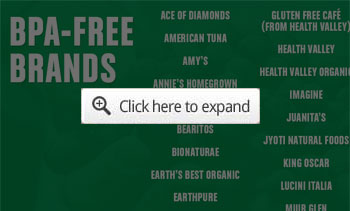Your Kitchen Pantry Is Probably Still Full of Toxins
By Dr. Mercola
It’s widely known that bisphenol-A (BPA), an endocrine-disrupting chemical, is used in plastics, and as a result it’s been removed from many baby bottles, water bottles, and other plastic products.
Lesser known is the fact that BPA is also used to make BPA resins, which keep metal from corroding and breaking. It coats about 75 percent of cans in North America, which means if you eat canned foods, it’s likely a major source of BPA exposure for you.
In one study, eating canned soup for five days increased study participants' urinary concentrations of BPA by more than 1,000% compared to eating freshly made soup!1 Even as the health risks surrounding BPA have become too many to ignore, food manufacturers have been slow to remove this chemical from cans – and even if they do, you’re still not in the clear…
75 Common Food Brands Still Use BPA in Their Canned Products
The Environmental Working Group (EWG) analyzed 252 canned food brands in 2014 to reveal whether their cans are coated with a BPA-based epoxy lining. Seventy-eight brands are still using the chemical including those listed below:2
Why aren’t more food companies removing this toxic chemical from their products? The industry trade group the American Chemistry Council has continually insisted that BPA is safe, and has opposed both state and federal legislative proposals to ban the chemical.
The US Food and Drug Administration (FDA) has also supported its safety, and in 2014 issued an official announcement in reaffirming BPA's “safety.”3 The decision came after a review of 300 studies, even though more than 800 academic studies have concluded BPA may harm reproduction and development.4
Why did the FDA only review 300? And if there are 800 showing developmental harm, how is it that they managed to pick 300 that fail to make such a connection?
These are questions that remain to be answered, but one piece of good news from EWG’s report is that 31 brands now use BPA-free cans for all of their canned products. This included:5
BPA vs. BPS Options
Cans need to be lined with something, and you’ll typically have no way of knowing what that “something” is. Often, it’s a similar chemical known as bisphenol-S (BPS).
Unfortunately, BPS is not a safe alternative. Research has shown BPS has estrogenic activity comparable to estradiol, the most potent human estrogen. It was also found to be capable of enhancing estradiol-mediated cell signaling, making it a particularly potent endocrine disruptor.6
Furthermore, the study showed BPS can induce apoptosis (cell death) and interfere with cellular secretion of prolactin (PRL)—a hormone that regulates hundreds of biological functions, including metabolism, reproduction, and lactation.
Originally, BPS was heralded as a suitable alternative because it appeared to be less prone to leaching than BPA… but it must be getting into food because the majority of Americans already have detectable levels in their bodies. Scientific American noted:7
“BPS was a favored replacement because it was thought to be more resistant to leaching. If people consumed less of the chemical, the idea went, it would not cause any or only minimal harm. Yet BPS is getting out. Nearly 81 percent of Americans have detectable levels of BPS in their urine. And once it enters the body it can affect cells in ways that parallel BPA.”Unfortunately, even if a can (or plastic product) is labeled BPA-free, you can’t be sure it’s also free of BPS. And even if it doesn’t contain BPS, there’s a good chance it contains other harmful chemicals, like phthalates.
Banning BPS will not solve this problem, as there are many types of bisphenols, and simply switching from one to another is nothing but a game of toxic musical chairs.
At present, you may be paying more for a “BPA-free” product that is no safer than the old BPA-containing variety... You’re also exposed to a number of other chemicals courtesy of food and beverage containers,8 most of which have no warning labels at all.
What Are the Health Risks of BPA (and Possibly BPS)?
As an endocrine disrupter, BPA mimics or interferes with your body's hormones and "disrupts" your endocrine system. The glands of your endocrine system and the hormones they release influence almost every cell, organ, and function of your body.
It is instrumental in regulating mood, growth and development, tissue function, metabolism, as well as sexual function and reproductive processes. BPA has been linked to a number of health concerns, particularly in pregnant women, fetuses and young children, but also in adults, including:
Further, research involving humans has shown similar risks. For instance, BPA from cans or plastic bottles can raise your blood pressure within just a few hours of ingestion.9 And in an NHANES study, published in 2010, adults with the highest levels of BPA in their urine were more than twice as likely to develop coronary heart disease as those with the lowest levels.10
Structural damage to your brain Changes in gender-specific behavior, and abnormal sexual behavior Hyperactivity, increased aggressiveness, and impaired learning Early puberty, stimulation of mammary gland development, disrupted reproductive cycles, ovarian dysfunction, and infertility Increased fat formation and risk of obesity Stimulation of prostate cancer cells Altered immune function Increased prostate size and decreased sperm production
In addition, ovarian toxicity appears to be a particularly strong feature of BPA. Harvard researchers have found that higher BPA levels in women are linked to a reduced number of fertile eggs. According to the New York Times:11
“The accumulating research fuels rising concern among scientists that childhood exposure to BPA may well contribute to female infertility, and that adult exposure may result in a shorter reproductive life span. ‘I think most scientists working today agree that BPA is an ovarian toxicant,’ Dr. Flaws said. A review of research into BPA, published this summer in the journal Environmental Health Perspectives,12 noted that ovarian toxicity is among the most consistent and strongest effects found ‘in both animal models and in women.’”
Other Products Where BPA and Endocrine-Disrupting Chemicals Are Found
Cutting out canned goods will not be enough to rid your pantry of BPA. Aside from canned goods, BPA is often found in:
Even if you manage to avoid BPA or BPS, you’re likely to come into contact with phthalates, which are used as plasticizers in everything from vinyl flooring to detergents and toys. This hormone disrupter can also be found in soaps, shampoos, and cosmetics of all kinds. They’re even used as food additives!
- Soda cans
- Certain plastics and food packaging
- Certain tooth sealants
- Certain BPA-free plastics
- Receipts and currency (seek to limit or avoid carrying receipts in your wallet or purse, as it appears the chemical is transferring onto other surfaces it touches.
It would also be wise to wash your hands after handling receipts and currency, and avoid handling them particularly if you've just put on lotion or have any other greasy substance on your hands, as this may increase your exposure)
Research has linked phthalates with the feminization of males of all species. These chemicals have disrupted the endocrine systems of wildlife, causing testicular cancer, genital deformations, low sperm counts, and infertility in polar bears, deer, whales, and otters, just to name a few.
Scientists believe phthalates are responsible for a similar pattern in humans as well. The effects of phthalate exposure are very similar to that of bisphenols (BPA and BPS), which isn’t surprising considering they all affect your endocrine system and sex hormones. The best way to steer clear of such chemicals is to eat fresh, unprocessed foods, which will minimize your exposure to chemicals in food packaging of all kinds.
15 Tips to Reduce Your Exposure to Endocrine-Disrupting Chemicals
Although it's virtually impossible to steer clear of ALL potentially hazardous chemicals, you can certainly minimize your exposure by keeping some key principles in mind.
- Eat mostly fresh whole foods. Processed and packaged foods are a common source of BPA and phthalates—particularly cans, but also foods packaged in plastic wrap.
- Buy products that come in glass bottles and jars rather than plastic or cans. Brick-shaped cardboard cartons may also be preferable to plastic or cans.
- Store your food and beverages in glass, rather than plastic, and avoid using plastic wrap. Use glass containers if heating food in your microwave, as heat tends to increase the release of chemicals from plastic.
- Use glass baby bottles for your infants.
- Be careful with cash register receipts. If you use a store regularly, encourage the management to switch to BPA-free receipts. I shop at Publix for my food and when I called them about the receipts it turns out they had already switched. Nevertheless it is wise to limit your contact with all these receipts.
- Look for products that are made by companies that are earth-friendly, animal-friendly, sustainable, certified organic, and GMO-free. This applies to everything from food and personal care products to building materials, carpeting, paint, baby items, furniture, mattresses, and more. When redoing your home, look for "green," toxin-free alternatives in lieu of regular paint and vinyl floor coverings, the latter of which is another source of phthalates.
- Choose toys made from natural materials to avoid plastic chemicals like phthalates and BPA/BPS, particularly for items your child may be prone to suck or chew on.
- Breastfeed your baby exclusively if possible, for at least the first year (as you will avoid phthalates exposure from infant formula packaging and plastic bottles/nipples).
- Use natural cleaning products, or make your own.
- Switch over to organic toiletries, including shampoo, toothpaste, antiperspirants, and cosmetics. EWG's Skin Deep database can help you find personal care products that are free of phthalates and other potentially dangerous chemicals.13
- Replace your vinyl shower curtain with a fabric one.
- Replace feminine hygiene products (tampons and sanitary pads) with safer alternatives. While most ingredients in feminine hygiene products are undisclosed, tests suggest they may contain dioxins and petrochemical additives.
- Look for fragrance-free products; phthalates are often used to help the product hold its fragrance longer. Artificial fragrance can also contain hundreds—even thousands—of potentially toxic chemicals. Avoid fabric softeners, dryer sheets, air fresheners, and scented candles for the same reason.
- Check your home's tap water for contaminants and filter the water if necessary. You may also want to use an alternative to PVC pipes for your water supply.
- Teach your children not to drink water from the garden hose, as many are made with phthalate-containing plastics.


No comments:
Post a Comment